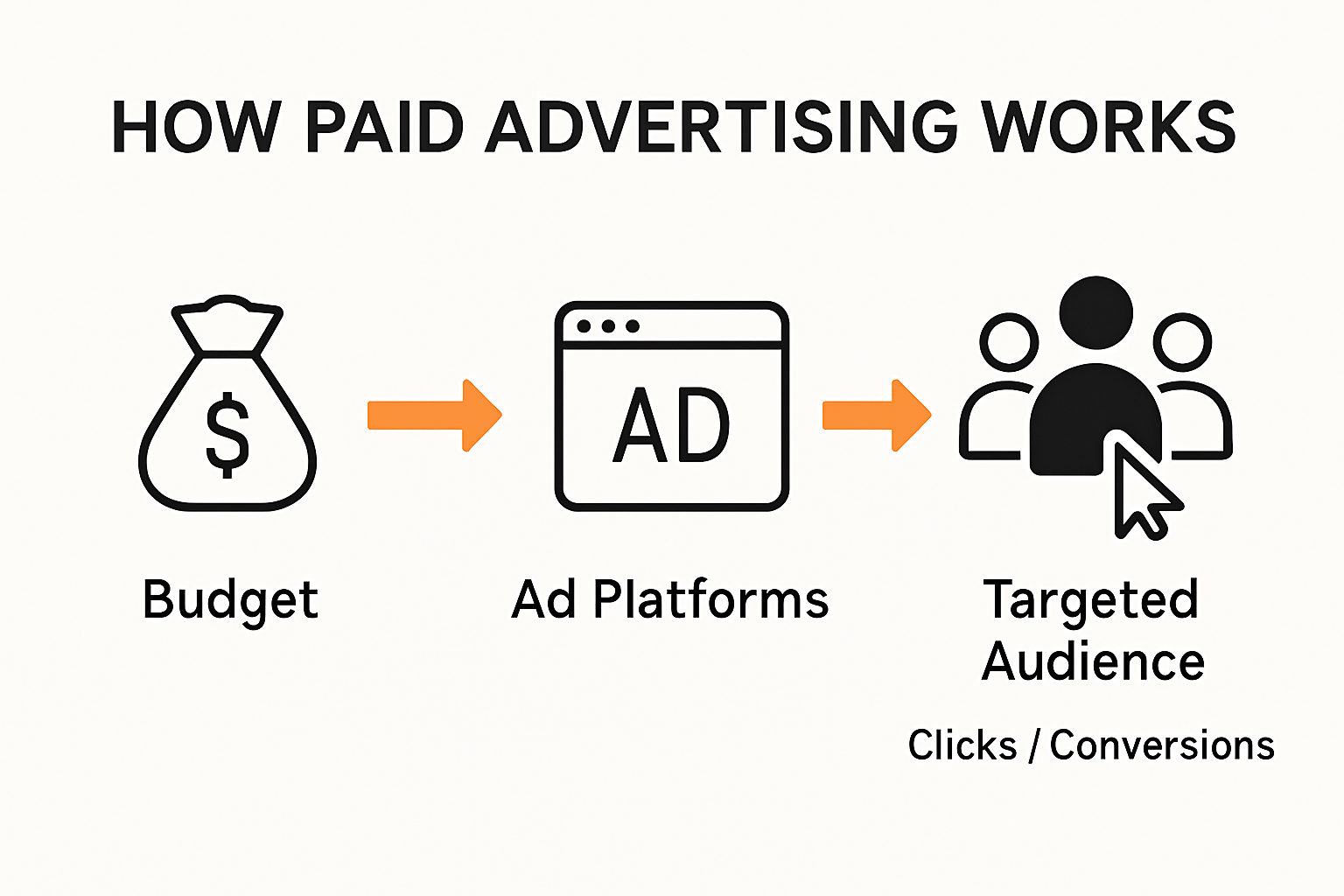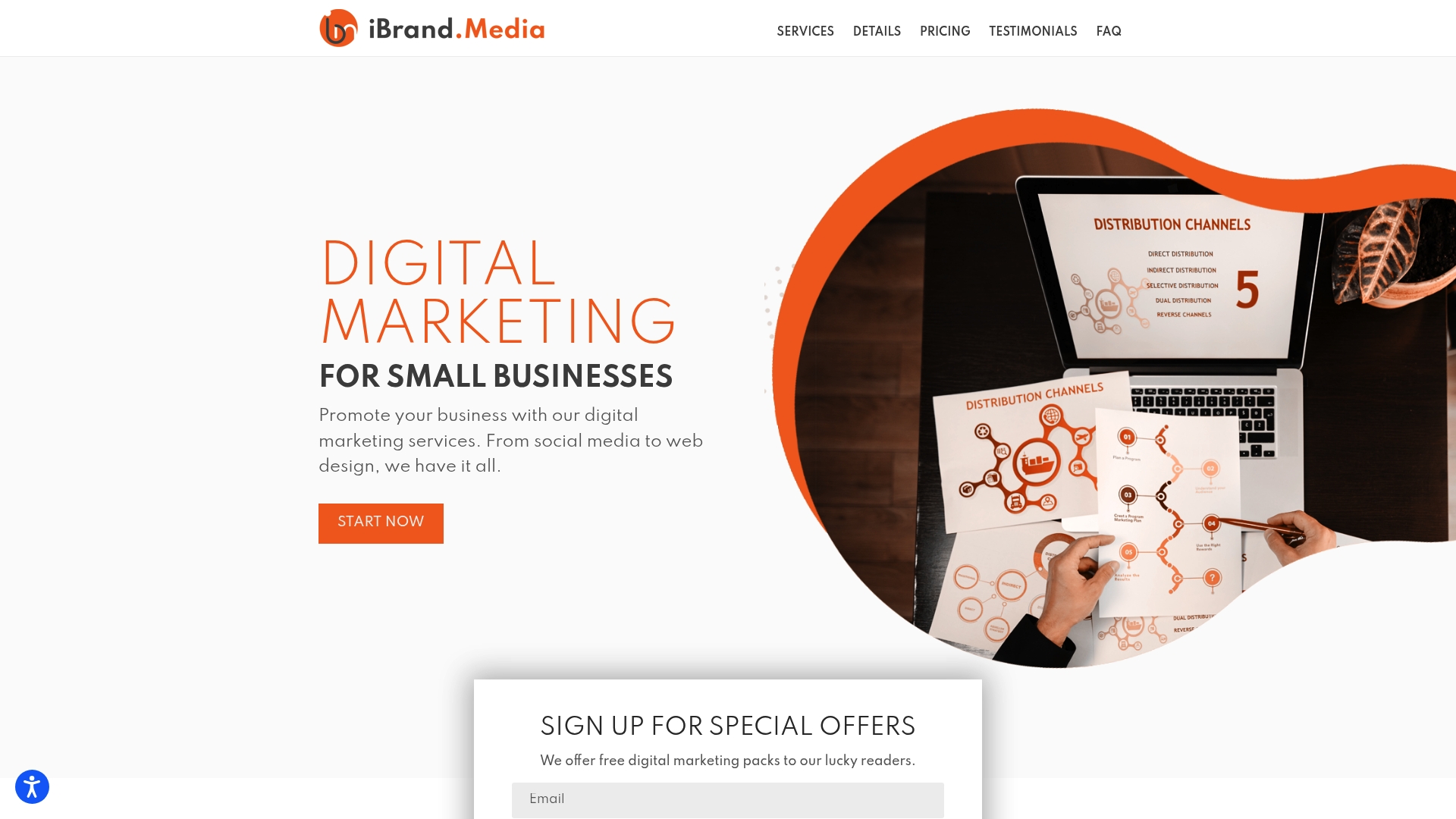
Small businesses are constantly looking for ways to stand out and attract new customers online. Paid advertising looks expensive at first glance, but the story is changing fast. Digital ad spending in the US hit a jaw-dropping $190 billion in 2022—more than ever before. The real surprise is that even tiny companies now have proven, cost-effective ways to tap into this huge digital ad market, leveling the playing field in ways nobody expected.
Table of Contents
- What Is Paid Advertising And How It Works
- Top Paid Ad Platforms For Local Businesses
- Setting Your Paid Advertising Budget Wisely
- Best Practices To Boost Your Paid Ad Results
Quick Summary
| Takeaway | Explanation |
|---|---|
| Leverage Targeted Platforms | Utilize platforms like Google Ads and social media for precise targeting to reach your potential customers effectively. |
| Allocate Your Budget Wisely | Follow the SBA guideline of allocating 7-8% of gross revenue for marketing, focusing a strategic portion towards digital advertising. |
| Craft Compelling Ad Content | Develop personalized ads with a clear value proposition and strong call-to-action to increase engagement rates. |
| Continuously Optimize Performance | Regularly track critical performance metrics and apply insights for ongoing improvements in ad strategies. |
| Start Small and Scale | Experiment with smaller budget campaigns to identify successful strategies before expanding your advertising spend. |
What Is Paid Advertising and How It Works
Paid advertising represents a strategic approach for small businesses to amplify their online visibility and reach potential customers quickly. Unlike organic marketing methods, paid advertising allows businesses to purchase targeted ad placements across digital platforms to generate immediate traffic and leads.
The Fundamental Mechanics of Paid Advertising
At its core, paid advertising operates on a simple principle: businesses pay to display their promotional content in specific digital spaces where their target audience is most likely to see it. Digital marketing experts at WordStream reveal that businesses can expect to reach approximately 34% more potential customers through targeted paid advertising strategies compared to organic methods alone.
The primary payment models in paid advertising include:
- Cost Per Click (CPC): Advertisers pay each time a user clicks on their advertisement. This model ensures you only pay when someone shows direct interest in your content.
- Cost Per Impression (CPM): Businesses are charged based on the number of times their ad is displayed, regardless of user interaction.
- Cost Per Acquisition (CPA): Payment occurs only when a specific action is completed, such as a sale or signup.

Understanding Digital Advertising Platforms
Modern paid advertising spans multiple digital platforms, each offering unique targeting capabilities. Research from Statista indicates digital advertising spending in the United States reached $190 billion in 2022, demonstrating the massive scale and importance of these channels.
Small businesses can leverage platforms like:
- Google Ads for search engine marketing
- Social media advertising on Facebook, Instagram, and LinkedIn
- Display advertising networks
- Programmatic advertising platforms
Successful paid advertising requires a strategic approach. Businesses must understand their target audience, craft compelling ad content, select appropriate platforms, and continuously monitor and optimize their campaigns. By focusing on precise targeting and engaging creative elements, small businesses can maximize their return on investment and effectively compete in the digital marketplace.
The key is not just spending money on ads but spending it intelligently. This means understanding your audience’s preferences, behaviors, and pain points. A well-designed paid advertising strategy can transform how small businesses connect with potential customers, turning advertising expenses into valuable business growth opportunities.
With our guide on affordable online advertising strategies, you can dive deeper into implementing cost-effective paid advertising techniques tailored for small business success in 2025.
Top Paid Ad Platforms for Local Businesses
Local businesses have an unprecedented opportunity to reach targeted audiences through specialized digital advertising platforms. The right platform can transform how small businesses connect with potential customers, driving growth and increasing visibility in competitive markets.
Google Ads: The Search Engine Powerhouse
Google Ads remains the most powerful advertising platform for local businesses seeking immediate visibility. Research from LocaliQ indicates that Google Ads can generate an average return of $2 for every $1 spent, making it an incredibly effective marketing tool for small businesses.
Key advantages of Google Ads include:
- Precise Local Targeting: Businesses can target customers within specific geographic radius
- Flexible Budget Control: Advertisers can set daily spending limits
- Performance Tracking: Detailed analytics provide insights into ad performance
Social Media Advertising Platforms
Social media platforms offer nuanced advertising options that allow local businesses to reach highly specific demographic groups. NerdWallet highlights several top platforms for local business advertising:
- Facebook Ads: Unparalleled audience targeting capabilities
- Instagram Ads: Visual platform ideal for service and product-based businesses
- LinkedIn Ads: Perfect for B2B service providers and professional networks
- TikTok Ads: Emerging platform with high engagement for younger demographics
Each platform offers unique targeting options. Facebook, for instance, allows businesses to target users based on location, interests, behavior, and detailed demographic information. Instagram provides visually driven ad formats perfect for showcasing local services or products.
Below is a summary table comparing key digital ad platforms available to local businesses based on their unique strengths and targeting capabilities.
| Platform | Audience Strength | Ideal For | Notable Targeting Feature |
|---|---|---|---|
| Google Ads | Broad intent-based searchers | Local search, all business types | Geographic radius, search keyword targeting |
| Facebook Ads | Diverse, highly active users | Community, lifestyle businesses | Interests, behavior, detailed demographics |
| Instagram Ads | Visual, younger audiences | Retail, food, events, lifestyle | Visual-first formats, location-based targeting |
| LinkedIn Ads | Professionals, B2B decision makers | B2B, services, recruiting | Job title, industry, company targeting |
| TikTok Ads | Young, trend-focused engagements | Gen Z, creative brands | Interest targeting, creator partnerships |
Cost-Effective Advertising Strategies
Budget-conscious local businesses need strategic approaches to maximize advertising impact. Our comprehensive guide on local advertising provides detailed insights into cost-effective techniques.
Small businesses should consider:
- Starting with smaller budget experiments
- Focusing on highly targeted audience segments
- Continuously monitoring and adjusting ad performance
- Utilizing platform-specific tools for optimization
Successful paid advertising requires ongoing learning and adaptation. Local businesses must remain flexible, track performance metrics, and be willing to adjust strategies based on real-world results. By understanding each platform’s strengths and targeting capabilities, small businesses can create powerful advertising campaigns that deliver measurable growth and customer engagement.

Setting Your Paid Advertising Budget Wisely
Budget allocation is a critical aspect of paid advertising that can make or break a small business’s marketing strategy. Smart financial planning ensures that every dollar spent generates maximum return and supports sustainable business growth.
Understanding Budget Allocation Principles
The U.S. Small Business Administration recommends that small businesses allocate approximately 7-8% of their gross revenue to marketing efforts. Within this allocation, digital advertising should receive a strategic portion of the budget. This percentage isn’t a one-size-fits-all approach but provides a foundational guideline for businesses determining their advertising investment.
Key considerations for budget allocation include:
- Revenue Percentage: Align advertising spend with current business revenue
- Business Stage: Newer businesses might need to invest more aggressively
- Industry Competitiveness: Some sectors require higher advertising investments
- Growth Objectives: Match advertising budget with specific business expansion goals
Below is a summary table outlining the main factors to consider when allocating a budget for paid advertising as discussed in this section.
| Factor | Explanation |
|---|---|
| Revenue Percentage | Spend around 7-8% of gross revenue on marketing |
| Business Stage | New businesses may require larger allocation |
| Industry Competitiveness | More competitive sectors may need higher budgets |
| Growth Objectives | Tailor budget to match expansion plans |
| Digital Ad Proportion | Assign a strategic portion to digital within total marketing spend |
Strategic Budget Planning Techniques
The U.S. Chamber of Commerce advises businesses to set clear, defined goals for each advertising campaign. This means breaking down your budget into specific, measurable objectives rather than spending randomly across platforms.
Effective budget planning involves:
- Conducting thorough market research
- Identifying most responsive customer segments
- Testing different platforms with smaller initial investments
- Tracking performance metrics meticulously
Maximizing Budget Efficiency
FedEx research suggests that 15-20% of marketing budgets should be dedicated specifically to advertising costs. This approach ensures businesses maintain financial flexibility while investing strategically in customer acquisition.
To optimize budget efficiency, small businesses should:
- Start with lower-cost platforms
- Use platform-specific targeting tools
- Monitor cost-per-acquisition consistently
- Be prepared to reallocate funds based on performance
Successful advertising budgeting is an ongoing process of learning and adaptation. Small businesses must remain flexible, continuously analyze their return on investment, and be willing to adjust strategies. Our comprehensive guide on affordable advertising strategies provides additional insights into making the most of limited marketing resources.
Remember that the goal isn’t just spending money on ads but investing intelligently in platforms and strategies that directly contribute to business growth. By approaching paid advertising with a strategic, data-driven mindset, small businesses can transform their marketing expenses into powerful growth engines.
Best Practices to Boost Your Paid Ad Results
Maximizing paid advertising effectiveness requires a strategic approach that goes beyond simple ad placement. Small businesses must develop sophisticated techniques to ensure their advertising investments generate meaningful results and sustainable growth.
Crafting Compelling Ad Creatives
Digital marketing experts at HubSpot highlight that ads with personalized content can increase engagement rates by up to 42%. Creating ad content that resonates with your target audience involves understanding their specific needs, pain points, and motivations.
Key elements of high-performing ad creatives include:
- Clear Value Proposition: Communicate immediate benefits
- Strong Call-to-Action: Use compelling, action-oriented language
- Visual Appeal: Incorporate high-quality, relevant imagery
- Emotional Connection: Address audience challenges directly
Advanced Targeting and Optimization Strategies
Google’s advertising research demonstrates that precise audience targeting can improve ad performance by up to 70%. Small businesses should leverage platform-specific targeting tools to reach the most relevant potential customers.
Effective targeting techniques include:
- Utilizing detailed demographic filters
- Creating custom audience segments
- Implementing retargeting campaigns
- Analyzing audience behavior patterns
- Continuously refining audience parameters
Measuring and Improving Ad Performance
Successful paid advertising requires continuous monitoring and data-driven optimization. Our guide on effective online advertising strategies provides comprehensive insights into performance tracking.
Critical performance metrics to track:
- Click-through rates
- Conversion rates
- Cost per acquisition
- Return on ad spend
- Engagement levels
Small businesses should adopt a systematic approach to ad optimization. This means regularly reviewing performance data, experimenting with different ad variations, and being willing to pivot strategies based on real-world results. A/B testing becomes crucial in understanding what resonates with your target audience.
The most successful paid advertising campaigns are those that remain flexible and responsive. Businesses must view their advertising efforts as dynamic processes, constantly evolving to meet changing market conditions and customer preferences. By combining creative content, precise targeting, and rigorous performance analysis, small businesses can transform their paid advertising from an expense into a powerful growth engine.
Remember that paid advertising is not about spending the most money but about spending smartly. Each advertisement should be a calculated investment designed to deliver tangible business results.
Frequently Asked Questions
What is paid advertising?
Paid advertising is a marketing strategy where businesses pay to display their ads on various digital platforms to quickly reach their target audience and drive traffic.
How can small businesses benefit from paid advertising?
Small businesses can benefit from paid advertising by increasing their online visibility, targeting specific demographics, and achieving a higher return on investment compared to organic marketing methods.
What are the most effective platforms for local businesses to advertise on?
The most effective platforms for local businesses include Google Ads for search engine visibility, and social media platforms like Facebook, Instagram, and LinkedIn for targeted audience engagement.
How should small businesses allocate their advertising budget?
Small businesses should allocate about 7-8% of their gross revenue to marketing, with a strategic portion dedicated to digital advertising. It’s essential to consider factors like revenue, business stage, and industry competitiveness when planning the budget.
Ready to Turn Every Ad Dollar Into Real Growth?
If you have read this far, you are probably struggling with budget limitations, unclear results, or confusion about how to manage paid ads for your small business. The article explained how crucial it is to spend wisely, choose the right platforms, and measure every click. But executing a smart paid advertising plan is not easy when you already wear so many hats. At ibrand.media, our mission is to help small businesses skip the guesswork and finally see quick wins from digital campaigns.

Do not let uncertainty or limited time hold back your business goals. Our team combines tailored ad strategies, real-time performance tracking, and proven local marketing expertise to turn your advertising spend into new leads and sales. Ready to move from learning about ads to launching campaigns that work? Explore more examples and get started today at Uncategorized | Ibrandmedia or connect with us directly at ibrand.media. Take your next step and claim an affordable, results-focused plan before your competition does.
Recommended
- Affordable Online Advertising Tips for Small Businesses 2025 | Ibrandmedia
- Best Online Advertising Channels for Small Businesses in 2025 | Ibrandmedia
- Effective Online Advertising Tips for Small Businesses 2025 | Ibrandmedia
- How to Run Social Ads: A 2025 Guide for Local Small Businesses | Ibrandmedia
- Top-Rated PPC Firms: Who Should You Trust with Your Ad Spend? | 12AM Agency
- PPC Agency Southampton | Mitchell & Stones

Recent Comments